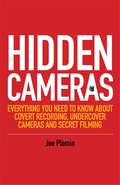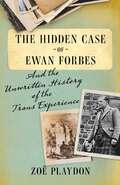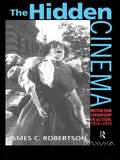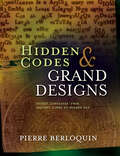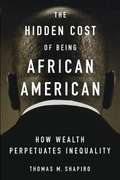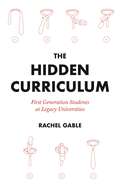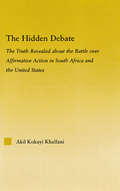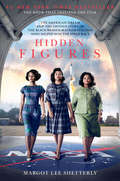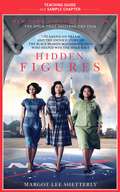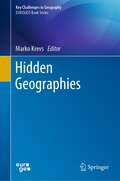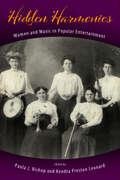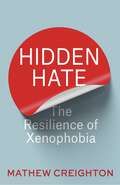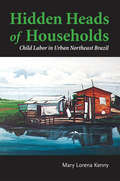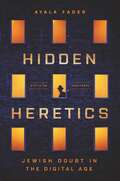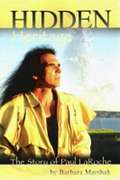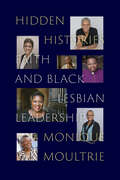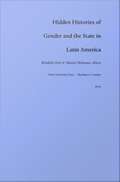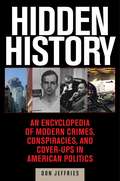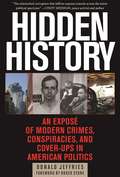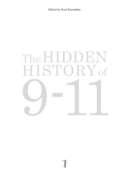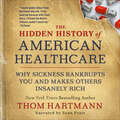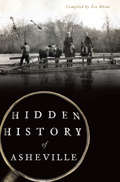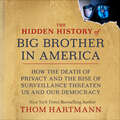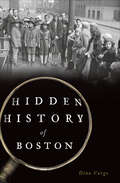- Table View
- List View
Hidden Cameras: Everything You Need to Know About Covert Recording, Undercover Cameras and Secret Filming
by Joe PlominThe complete and authoritative guide to the use of hidden cameras to expose abuse or wrongdoing.Secret filming is no longer the preserve of specialists, professional journalists and private investigators. Drawing on the author's own experience producing undercover documentaries and wearing secret cameras, this book explains covert recording for the general public, including specific advice on the practicalities of using a phone or covert camera to record evidence. It considers the legal and ethical issues and provides vital information for anyone who may use or encounter secret filming, including the people or organisations that might be filmed, regulators, social workers, local government officials and anyone who may encounter it in court. It also looks to the future of covert filming and the implications of technological advances, such as drone cameras.
The Hidden Case of Ewan Forbes: And the Unwritten History of the Trans Experience
by Zoë PlaydonThe life story of an aristocratic Scottish trans man—whose secret 1968 legal case had a profound impact on trans rights for decades.Ewan Forbes was born to a wealthy, landowning family, holders of a baronetcy, in Aberdeenshire, Scotland, in 1912. Assigned female at birth, his true identity was nevertheless clear even in childhood—and so, with the support of his mother, he was taken to European specialists and eventually treated with early preparations of synthetic testosterone. Raised as a boy at home but socially obliged to present himself as a girl in public until his official coming out to the Queen, Ewan grew up, became a doctor, and got married. (This required him to change the sex on his birth certificate, which was possible at that time without much fuss.) For decades, he lived a quiet life as a husband, doctor, and a pillar of the local community. But in 1965, Ewan&’s older brother died unexpectedly—meaning that Ewan was set to inherit the baronetcy. His title could only be inherited by the next oldest man in the family and when his cousin John—spurred on by Ewan&’s sister—contested the inheritance he was forced to defend his male status in Scotland&’s supreme civil court, where he prevailed. This hugely important case would have changed the lives of trans people across the world—if it hadn&’t been hidden. The hearing was conducted privately, the media were gagged, and those involved were sworn to secrecy. The case remained unknown until 1996 and now finally is described here, along with the life of Ewan Forbes, for the first time. Enlightening and galvanizing, The Hidden Case of Ewan Forbes is a singular contribution to trans history and the ongoing struggle for trans rights.
The Hidden Cinema: British Film Censorship in Action 1913-1972 (Cinema and Society)
by Dr James Robertson James RobertsonHow does film censorship work in Britain? Jim Robertson's new paperback edition of The Hidden Cinema argues that censorship has had a far greater influence on British film history than is often apparent, creating the `hidden cinema' of the title. Robertson charts the role of the British Board of Film Censors, established in 1913, and the histories of a variety of noteworthy films including Battleship Potemkin and No Orchids for Miss Blandish and revealing how censorship continues to exert a marked influence on many important films - like the controversial A Clockwork Orange - some of which have now vanished from British screens altogether. This edition includes a brand new section on Bernardo Bertolucci's Last Tango in Paris, immediately engulfed in censorship wrangles on its release in 1972.
Hidden Codes & Grand Designs: Secret Languages from Ancient Times to Modern Day
by Pierre BerloquinAn exploration of how codes—both cipher and aesthetic—have come to exist in history from Pythagoras through the Knights Templar to Turing and more.Did the Masons encode messages in walls—and even in the street plan of Washington, D.C.? Does the Hebrew Bible conceal hidden mysteries? Ingenious methods for encoding secrets have taken many amazing turns through the ages, from the military signals the Romans flashed from hilltop to hilltop, to the computer codes that guard your cash at the ATM. Pierre Berloquin, one of France’s leading puzzle book authors, takes you on a tour of them all in a book full of astonishing historical insights. With more than 150 brain-teasing problems for readers to solve for themselves, this is a journey beyond the gee-whiz and deep into the how-to of codes, ciphers, and other secret communication systems.
The Hidden Cost of Being African American: How Wealth Perpetuates Inequality
by Thomas M. ShapiroOver the past three decades, racial prejudice in America has declined significantly and many African American families have seen a steady rise in employment and annual income. But alongside these encouraging signs, Thomas Shapiro argues in The Hidden Cost of Being African American, fundamental levels of racial inequality persist, particularly in the area of asset accumulation--inheritance, savings accounts, stocks, bonds, home equity, and other investments. Shapiro reveals how the lack of these family assets along with continuing racial discrimination in crucial areas like home ownership dramatically impact the everyday lives of many black families, reversing gains earned in schools and on jobs, and perpetuating the cycle of poverty in which far too many find themselves trapped. Shapiro uses a combination of in-depth interviews with almost 200 families from Los Angeles, Boston, and St. Louis, and national survey data with 10,000 families to show how racial inequality is transmitted across generations. We see how those families with private wealth are able to move up from generation to generation, relocating to safer communities with better schools and passing along the accompanying advantages to their children. At the same time those without significant wealth remain trapped in communities that don't allow them to move up, no matter how hard they work. Shapiro challenges white middle class families to consider how the privileges that wealth brings not only improve their own chances but also hold back people who don't have them. This "wealthfare" is a legacy of inequality that, if unchanged, will project social injustice far into the future. Showing that over half of black families fall below the asset poverty line at the beginning of the new century, The Hidden Cost of Being African American will challenge all Americans to reconsider what must be done to end racial inequality.
The Hidden Curriculum: First Generation Students at Legacy Universities
by Rachel GableA revealing look at the experiences of first generation students on elite campuses and the hidden curriculum they must master in order to succeedCollege has long been viewed as an opportunity for advancement and mobility for talented students regardless of background. Yet for first generation students, elite universities can often seem like bastions of privilege, with unspoken academic norms and social rules. The Hidden Curriculum draws on more than one hundred in-depth interviews with students at Harvard and Georgetown to offer vital lessons about the challenges of being the first in the family to go to college, while also providing invaluable insights into the hurdles that all undergraduates face.As Rachel Gable follows two cohorts of first generation students and their continuing generation peers, she discovers surprising similarities as well as striking differences in their college experiences. She reveals how the hidden curriculum at legacy universities often catches first generation students off guard, and poignantly describes the disorienting encounters on campus that confound them and threaten to derail their success. Gable shows how first-gens are as varied as any other demographic group, and urges universities to make the most of the diverse perspectives and insights these talented students have to offer.The Hidden Curriculum gives essential guidance on the critical questions that university leaders need to consider as they strive to support first generation students on campus, and demonstrates how universities can balance historical legacies and elite status with practices and policies that are equitable and inclusive for all students.
The Hidden Debate: The Truth Revealed about the Battle over Affirmative Action in South Africa and the United States (African Studies)
by Akil Kokayi KhalfaniThe Hidden Debate is a fresh and cutting-edge comparative analysis of the ongoing and highly charged social conflict over affirmative action in South Africa and the United States. The debate over affirmative action has raged for over 30 years in the United States and since the early 1990s in South Africa with minimal agreement or resolution. In part this discord remains because scholars, journalists, politicians, and other social analysts have failed to properly specify and examine the problem.
Hidden Figures: The American Dream and the Untold Story of the Black Women Mathematicians Who Helped Win the Space Race
by Margot Lee Shetterly<P>The phenomenal true story of the black female mathematicians at NASA whose calculations helped fuel some of America's greatest achievements in space. Soon to be a major motion picture starring Taraji P. Henson, Octavia Spencer, Janelle Monae, Kirsten Dunst, and Kevin Costner. <P>Before John Glenn orbited the earth, or Neil Armstrong walked on the moon, a group of dedicated female mathematicians known as "human computers" used pencils, slide rules and adding machines to calculate the numbers that would launch rockets, and astronauts, into space. Among these problem-solvers were a group of exceptionally talented African American women, some of the brightest minds of their generation. <P>Originally relegated to teaching math in the South's segregated public schools, they were called into service during the labor shortages of World War II, when America's aeronautics industry was in dire need of anyone who had the right stuff. Suddenly, these overlooked math whizzes had a shot at jobs worthy of their skills, and they answered Uncle Sam's call, moving to Hampton, Virginia and the fascinating, high-energy world of the Langley Memorial Aeronautical Laboratory. <P>Even as Virginia's Jim Crow laws required them to be segregated from their white counterparts, the women of Langley's all-black "West Computing" group helped America achieve one of the things it desired most: a decisive victory over the Soviet Union in the Cold War, and complete domination of the heavens. <P>Starting in World War II and moving through to the Cold War, the Civil Rights Movement and the Space Race, Hidden Figures follows the interwoven accounts of Dorothy Vaughan, Mary Jackson, Katherine Johnson and Christine Darden, four African American women who participated in some of NASA's greatest successes. It chronicles their careers over nearly three decades they faced challenges, forged alliances and used their intellect to change their own lives, and their country's future.
Hidden Figures Teaching Guide: Teaching Guide and Sample Chapter
by Margot Lee ShetterlyThe #1 New York Times bestsellerThe phenomenal true story of the black female mathematicians at NASA whose calculations helped fuel some of America’s greatest achievements in space. Soon to be a major motion picture starring Taraji P. Henson, Octavia Spencer, Janelle Monae, Kirsten Dunst, and Kevin Costner. Before John Glenn orbited the earth, or Neil Armstrong walked on the moon, a group of dedicated female mathematicians known as “human computers” used pencils, slide rules and adding machines to calculate the numbers that would launch rockets, and astronauts, into space. Among these problem-solvers were a group of exceptionally talented African American women, some of the brightest minds of their generation. Originally relegated to teaching math in the South’s segregated public schools, they were called into service during the labor shortages of World War II, when America’s aeronautics industry was in dire need of anyone who had the right stuff. Suddenly, these overlooked math whizzes had a shot at jobs worthy of their skills, and they answered Uncle Sam’s call, moving to Hampton, Virginia and the fascinating, high-energy world of the Langley Memorial Aeronautical Laboratory. Even as Virginia’s Jim Crow laws required them to be segregated from their white counterparts, the women of Langley’s all-black “West Computing” group helped America achieve one of the things it desired most: a decisive victory over the Soviet Union in the Cold War, and complete domination of the heavens. Starting in World War II and moving through to the Cold War, the Civil Rights Movement and the Space Race, Hidden Figures follows the interwoven accounts of Dorothy Vaughan, Mary Jackson, Katherine Johnson and Christine Darden, four African American women who participated in some of NASA’s greatest successes. It chronicles their careers over nearly three decades they faced challenges, forged alliances and used their intellect to change their own lives, and their country’s future.
Hidden Geographies (Key Challenges in Geography)
by Marko KrevsThis book defines and discusses the term “hidden geographies” in two ways: systematically and by presenting a variety of examples of the research fields and topics concerning hidden geographies, with the aim of stimulating further basic and applied research in this area. While the term is quite rarely used in the scientific literature (more often as a figure of speech than to illustrate or problematize its deeper meaning), we argue that hidden geographies are everywhere and many of them have significant impacts on (other) natural and social phenomena and processes, subsequently triggering changes, for example in landscape, economy, culture, health or quality of life.The introductory section of the book conceptualises hidden geographies and discusses cognitive geography, symbolization of space, and the hidden geographies in mystical literature. Case studies of hidden environmental geographies address soils, air pollution, coastal pollution and the allocation of an astronomical tourism site. Revealing hidden historical and sacred places is illustrated through examples of the visualisation of the subterranean mining landscape, the analysis of the historical road network and trade, border stones and historical spatial boundaries, and the monastic Carthusian space. Hidden urban geographies are discussed in terms of the urban development of an entire city, presenting the role of geography in rescuing architecture, revealing illegal urbanisation, and the quality of habitation in Roma neighbourhoods. Case studies of hidden population geographies shed light on the ageing of rural populations and the impact of spatial-demographic disparities on fertility variations. Discussions of hidden social and economic geographies problematize recent social changes and conflicts in a country, present the implementation of the fourth industrial revolution and borders as hidden obstacles in the organisation of public transport. Hidden geographies are explicitly linked to perceptions and explanations in case studies that address local responses to perceived marginalisation in a city, the solo women travellers’ perceived risk and safety, and hidden geographical contexts of visible post-war landscapes.The book brings such a diversity of views, ideas and examples related to hidden geographies that can serve both to deepen their understanding and their various impacts on our lives and environment, and to attract further cross-disciplinary interest in considering hidden geographies – in research and in our every-day lives.
Hidden Harmonies: Women and Music in Popular Entertainment (American Made Music Series)
by Paula J. Bishop and Kendra Preston LeonardContributions by Christina Baade, Candace Bailey, Paula J. Bishop, Maribeth Clark, Brittany Greening, Tammy Kernodle, Kendra Preston Leonard, April L. Prince, Travis D. Stimeling, and Kristen M. TurnerFor every star, there are hundreds of less-recognized women who contribute to musical communities, influencing their aesthetics and expanding opportunities available to women. Hidden Harmonies: Women and Music in Popular Entertainment focuses not on those whose names are best known nor most celebrated but on the women who had power in collective or subversive ways hidden from standard histories.Contributors to Hidden Harmonies reexamine primary sources using feminist and queer methodologies as well as critical race theory in order to overcome previous, biased readings. The scholarship that results from such reexaminations explores topics from songwriters to the music of the civil rights movement and from whistling schools to musical influencers. These wide-ranging essays create a diverse and novel view of women's contribution to music and its production. With intelligence and care, Hidden Harmonies uncovers the fascinating figures behind decades of popular music.
Hidden Hate: The Resilience of Xenophobia
by Mathew CreightonOpposition to immigration has fueled a spate of populist movements in the United States and Europe. The potency of xenophobic politics is often explained in terms of factors such as economic insecurity, material competition, group identity, cultural conflicts, and social changes. These explanations have proven to be inadequate, particularly in often affluent and pluralistic contexts with relatively low levels of unemployment and poverty. How can these seemingly tolerant societies harbor intense antipathy toward migrants?Mathew Creighton develops a new model for understanding xenophobia by shining a light on the layers of intolerance concealed beneath the surface. Drawing on rich empirical evidence from innovative survey experiments conducted in the United States, the United Kingdom, Ireland, Norway, and the Netherlands, he argues that prejudice is often present but intentionally and strategically hidden. What can change, however, are the norms that govern the social acceptability of xenophobia. When the public expression of previously impermissible beliefs is pursued by politicians and society more broadly, the stigma of open intolerance lifts to reveal the true face of this once-masked xenophobia. Creighton challenges the assumption that overt anti-immigrant sentiment is mostly attributable to economic or social crises, showing that this narrative overlooks a substantial and largely stable reservoir of intolerance.Deeply researched, comparative, and generative, Hidden Hate provides timely and vital insight into the persistence of xenophobia.
Hidden Heads of Households: Child Labor In Urban Northeast Brazil (Teaching Culture: Utp Ethnographies For The Classroom Ser.)
by Mary Lorena KennyIn the cities of Northeast Brazil where 50 per cent of the population lives in poverty, children play a key role in the local economy—in their households, in formal jobs, and in the thriving informal sector (washing cars, shining shoes, scavenging for recyclables, etc.). Why children migrate to the city, how they negotiate their existence, and why they stay are just some of the questions addressed in this fascinating study. Mary Kenny spent close to 15 years in the urban areas of Northeast Brazil talking with and interviewing children. She even gave them disposable cameras to document their daily lives (many of the photographs they took are included). Rather than lament a lost childhood, or try to save these children, Kenny explores some of the complex conditions under which these children work and live. She illustrates how unrelenting scarcity shapes family and, by extension, children's options, decisions, and worldviews. The issues raised in this book are of critical importance. There are no easy answers, but listening to how these children define themselves and their circumstances is an important step towards understanding and ultimately solving economic and social inequality.
Hidden Heretics: Jewish Doubt in the Digital Age (Princeton Studies in Culture and Technology #27)
by Ayala FaderA revealing look at Jewish men and women who secretly explore the outside world, in person and online, while remaining in their ultra-Orthodox religious communities What would you do if you questioned your religious faith, but revealing that would cause you to lose your family and the only way of life you had ever known? Hidden Heretics tells the fascinating, often heart-wrenching stories of married ultra-Orthodox Jewish men and women in twenty-first-century New York who lead “double lives” in order to protect those they love. While they no longer believe that God gave the Torah to Jews at Mount Sinai, these hidden heretics continue to live in their families and religious communities, even as they surreptitiously break Jewish commandments and explore forbidden secular worlds in person and online. Drawing on five years of fieldwork with those living double lives and the rabbis, life coaches, and religious therapists who minister to, advise, and sometimes excommunicate them, Ayala Fader investigates religious doubt and social change in the digital age.The internet, which some ultra-Orthodox rabbis call more threatening than the Holocaust, offers new possibilities for the age-old problem of religious uncertainty. Fader shows how digital media has become a lightning rod for contemporary struggles over authority and truth. She reveals the stresses and strains that hidden heretics experience, including the difficulties their choices pose for their wives, husbands, children, and, sometimes, lovers. In following those living double lives, who range from the religiously observant but open-minded on one end to atheists on the other, Fader delves into universal quandaries of faith and skepticism, the ways digital media can change us, and family frictions that arise when a person radically transforms who they are and what they believe.In stories of conflicts between faith and self-fulfillment, Hidden Heretics explores the moral compromises and divided loyalties of individuals facing life-altering crossroads.
Hidden Heritage: The Story of Paul Laroche
by Barbara MarshakA spiritual legacy of one man's ordinary Minnesota lifestyle, suddenly fused with a rich, Lakota heritage that enabled him to cross boundaries far beyond his own expectations. Imagine waking up one day to discover you belong to a completely different culture. Paul Summers, a 38-year-old father of two, has just discovered that his birth mother was a member of the Lakota tribe from South Dakota. Drained physically, emotionally, and financially following his attempts to pursue a career in music, Paul hits rock bottom.
Hidden Heroes: America's Military Caregivers
by Terri Tanielian Rajeev Ramchand Michael P. Fisher Christine Anne Vaughan Thomas E. Trail Caroline Epley Phoenix Voorhies Michael William Robbins Eric Robinson Bonnie Ghosh-DastidarLittle has been reported about "military caregivers"--the population of those who care for wounded, ill, and injured military personnel and veterans. This report summarizes the results of a study designed to describe the magnitude of military caregiving in the United States today, as well as to identify gaps in the array of programs, policies, and initiatives designed to support military caregivers.
Hidden Histories: Faith and Black Lesbian Leadership
by Monique MoultrieIn Hidden Histories, Monique Moultrie collects oral histories of Black lesbian religious leaders in the United States to show how their authenticity, social justice awareness, spirituality, and collaborative leadership make them models of womanist ethical leadership. By examining their life histories, Moultrie frames queer storytelling as an ethical act of resistance to the racism, sexism, and heterosexism these women experience. She outlines these women’s collaborative, intergenerational, and leadership styles, and their concerns for the greater good and holistic well-being of humanity and the earth. She also demonstrates how their ethos of social justice activism extends beyond LGBTQ and racialized communities and provides other models of religious and community leadership. Addressing the invisibility of Black lesbian religious leaders in scholarship and public discourse, Moultrie revises modern understandings of how race, gender, and sexual identities interact with religious practice and organization in the twenty-first century.
Hidden Histories of Gender and the State in Latin America
by Elizabeth Dore Maxine MolyneuxThis collection examines the mutually influential interactions of gender and the state in Latin America from the late colonial period to the end of the twentieth century. Locating watershed moments in the processes of gender construction by the organized power of the ruling classes and in the processes by which gender has conditioned state-making, Hidden Histories of Gender and the State in Latin America remedies the lack of such considerations in previous studies of state formation. Along these lines, the book begins with two theoretical chapters by the editors, Elizabeth Dore and Maxine Molyneux. Dore opens by arguing against the prevailing view that the nineteenth century was marked by a gradual emancipation of women, while Molyneux considers how various Latin American state forms--liberal, corporatist, socialist, neoliberal--have more recently sought to incorporate women into their projects of social reform and modernization. These essays are followed by twelve case studies that examine how states have contributed to the normalization of male and female roles and relations. Covering an impressive breadth not only of historical time but also of geographical scope, this volume moves from Brazil to Costa Rica, from Mexico to Chile, traversing many countries in between. Contributors explore such topics as civic ritual in Bolivia, rape in war-torn Colombia, and the legal construction of patriarchy in Argentina. They examine the public regulation of domestic life, feminist lobby groups, class compromise, female slaves, and women in rural households--distinct, salient aspects of the state-gender relationship in specific countries at specific historical junctures. By providing a richly descriptive and theoretically grounded account of the interaction between state and gender politics in Latin America, this volume contributes to an important conversation between feminists interested in the state and political scientists interested in gender. It will be valuable to such disciplines as history, sociology, international comparative studies, and Latin American studies. Contributors. Mara Eugenia Chaves, Elizabeth Dore, Rebecca Earle, Jo Fisher, Laura Gotkowitz, Donna J. Guy, Fiona Macaulay, Maxine Molyneux, Eugenia Rodriguez, Karin Alejandra Rosemblatt, Ann Varley, Mary Kay Vaughan
Hidden History
by Donald JeffriesThe US government has spent half the time covering up conspiracies as it has spent helping the American people. In Hidden History, you will see the amount of effort over the past fifty years that our government has dedicated to lying and covering up the truth to the world.Starting with the assassination of President John F. Kennedy, Don Jeffries chronicles a wide variety of issues that have plagued our country's history. Whether it's the assassinations of MLK and RFK, Iran-Contra, the Oklahoma City bombing, TWA Flight 800, voting fraud, or 9/11, every major disaster or war that we've witnessed has somehow been distorted by those who are supposed to be protecting us.Jeffries also delves into extensive research on the death of John F. Kennedy Jr., and you'll be shocked by what he finds out.So whether you've only heard bits and pieces of these stories or have read several books on the topics, Hidden History is the book that belongs in every conspiracy theorist's library, as the information included in this encyclopedia has never been collected together in any other published work available. So sit down, strap in, and get ready to be shocked and awed by how much has been hidden from you by our government over the past fifty years.
Hidden History: An Exposé of Modern Crimes, Conspiracies, and Cover-Ups in American Politics
by Roger Stone Donald JeffriesThe US government has spent as much time covering up conspiracies as it has helping the American people. In Hidden History, you will see the amount of effort that our government has dedicated over the past fifty years to lying and covering up the truth to the world.Starting with the assassination of President John F. Kennedy, Don Jeffries chronicles a wide variety of issues that have plagued our country's history. Whether it is the assassinations of MLK and RFK, Iran-Contra, the Oklahoma City bombing, TWA Flight 800, voting fraud, or 9/11, every major disaster or war that we've sitnessed has somehow been distorted by those who are supposed to be protecting us. Jeffries also delves into extensive research on the death of John F. Kennedy, Jr. - and what he finds will shock you.So whether you've only heard bits and pieces of these stories or you've read several books on the topics, Hidden History is the book that belongs in every conspiracy theorist's library, as the information included here has never been collected together in any other published work available. So sit down, strap in, and get ready to be shocked and awed by how much has been hidden by our government over the past fifty years. Updated for 2016, this version features a new introduction by political insider Roger Stone.
The Hidden History of 9/11 (Research In Political Economy Ser.)
by Paul ZarembkaHow much insider trading occurred in the days leading up to 9-11? How compromised is the evidence against alleged hijackers? Why were there no military interceptions? To what extent does the testimony of more than five hundred firefighters differ from official reports of what happened at the World Trade Center buildings that day? How inseparably connected are Western covert operations to al-Qaeda? How is Islamophobia used to sustain US imperialism? What was the 9-11 Commission?With contributions from Nafeez Mosaddeq Ahmed, Four Arrows, David Ray Griffin, Jay Kolar, David MacGregor, Diana Ralph, Kevin Ryan, and Bryan Sacks, this path-breaking work examines 9-11 and its background, showing how much remains unknown and where further investigation and debate is needed.
The Hidden History of American Healthcare: Why Sickness Bankrupts You and Makes Others Insanely Rich (The\thom Hartmann Hidden History Ser. #6)
by Thom HartmannPopular progressive radio host and New York Times bestselling author Thom Hartmann reveals how and why attempts to implement affordable universal healthcare in the United States have been thwarted and what we can do to finally make it a reality. "For-profit health insurance is the largest con job ever perpetrated on the American people—one that has cost trillions of dollars and millions of lives since the 1940s,&” says Thom Hartmann.Other countries have shown us that affordable universal healthcare is not only possible but also effective and efficient. Taiwan's single-payer system saved the country a fortune as well as saving lives during the coronavirus pandemic, enabling the country to implement a nationwide coronavirus test-and-contact-trace program without shutting down the economy. This resulted in just ten deaths, while more than 500,000 people have died in the United States.Hartmann offers a deep dive into the shameful history of American healthcare, showing how greed, racism, and oligarchic corruption led to the current &“sickness for profit&” system. Modern attempts to create versions of government healthcare have been hobbled at every turn, including Obamacare.There is a simple solution: Medicare for all. Hartmann outlines the extraordinary benefits this system would provide the American people and economy and the steps we need to take to make it a reality. It's time for America to join every industrialized country in the world and make health a right, not a privilege.
Hidden History of Asheville (Hidden History)
by Zoe RhineThe milestones of Asheville's long history are well known to locals, but so many interesting stories are all but forgotten. Thankfully, the staff and volunteers of the North Carolina Room at Pack Memorial Library have unearthed the best of those hidden tales. Meet daredevil aviatrix Uva Shipman and Tempie Avery, who went from slavery to respected nurse and citizen. Learn the poignant tale behind the sad death of former mayor Gallatin Roberts and uncover the parts of old Asheville lost to the wrecking ball. These and many more historic episodes come to life in this collection compiled by North Carolina Room librarian Zoe Rhine.
The Hidden History of Big Brother in America: How the Death of Privacy and the Rise of Surveillance Threaten Us and Our Democracy (The\thom Hartmann Hidden History Ser. #7)
by Thom HartmannAmerica's most popular progressive radio host and New York Times bestselling author Thom Hartmann reveals how the government and corporate America misuse our personal data and shows how we can reclaim our privacy.Most Americans are worried about how companies like Facebook invade their privacy and harvest their data, but many people don't fully understand the details of how their information is being adapted and misused. In this thought-provoking and accessible book, Thom Hartmann reveals exactly how the government and corporations are tracking our every online move and using our data to buy elections, employ social control, and monetize our lives. Hartmann uses extensive, vivid examples to highlight the consequences of Big Data on all aspects of our lives. He traces the history of surveillance and social control, looking back to how Big Brother invented whiteness to keep order and how surveillance began to be employed as a way to modify behavior. As he states, &“The goal of those who violate privacy and use surveillance is almost always social control and behavior modification.&” Along with covering the history, Hartmann shows how we got to where we are today, how China—with its new Social Credit System—serves as a warning, and how we can and must avoid a similarly dystopian future. By delving into the Constitutional right to privacy, Hartmann reminds us of our civil right and shows how we can restore it.
Hidden History of Boston: History Through Architecture (Hidden History)
by Dina VargoQuirky and little-known true stories of one of America&’s most historic cities. Boston may play a big role in American history textbooks, but it also has quite a bit of forgotten past. For example, during the colonial era, riotous mobs celebrated their hatred of the pope in an annual celebration called Pope&’s Night. In 1659, Christmas was made illegal, a ban by the Puritans that remained in effect for twenty-two years. William Monroe Trotter published the Boston Guardian, an independent African American newspaper, and was a beacon of civil rights activism at the turn of the century. And in more recent times, a centuries-long turf war played out on the streets of quiet Chinatown, ending in the massacre of five men in a back alley in 1991. Author and historian Dina Vargo shines a light into the cobwebbed corners of Boston&’s hidden history in this riveting read, complete with illustrations.
